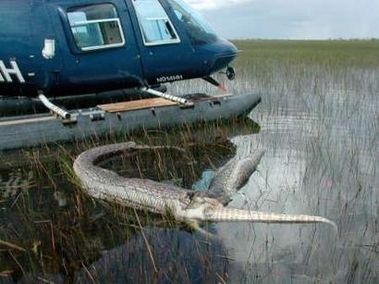http://www.sun-sentinel.com/news/palm-beach/fl-python-killing-20120130,0,6326000.story
Burmese pythons have virtually wiped out raccoons, marsh rabbits, opossums and other once-common mammals in the southern region of Everglades National Park, according to a nine-year study that shows the snakes' devastating impact on the park's wildlife.
The loss of so many significant species from part of the park is certain to have significant repercussions throughout the food web, said Michael Dorcas, lead author of the study published Monday in the Proceedings of the National Academy of Sciences.
For the study, scientists gathered information about the park's mammal populations through surveys of park roads from 2003 to 2011. They then compared the results to data from the 1990s, before the arrival of the pythons.
"When we did the calculations, the percentage declines were just astonishing," said Dorcas, a professor of biology at Davidson College in North Carolina. In the area where the snakes have been established the longest, raccoons had declined by 99.3 percent, opossums by 98.9 percent and bobcats by 87.5 percent. Marsh rabbits, cottontail rabbits and foxes had completely disappeared.
No one knows how many Burmese pythons live in South Florida, although estimates commonly run into the tens of thousands. Over the past 12 years or so, 1,825 have been captured. They arrived via the exotic pet industry, with the theories being that they either escaped from wholesalers' buildings destroyed by Hurricane Andrew or were released by owners sick of caring for giant snakes.
Linda Friar, spokeswoman for Everglades National Park, said the park will continue studying and trying to capture the snakes. In additional to park personal, 30 volunteers hold permits to capture them. Last year, 169 Burmese pythons were captured in South Florida, down from 322 the previous year, likely due to a cold snap that killed a lot of them. She said the park is experimenting with eradication techniques but the snakes are "evasive and they're difficult to find."
Although the study looked at the impact on common species, the authors said the results show a high risk to rare species such as the Florida panther. In its native habitat in southern Asia, the python has been known to kill leopards, so it could be well within its ability to take down a Florida panther.
"This severe decline in mammals is of significant concern to the overall health of the Park's large and complex ecosystem," said Everglades National Park superintendent Dan Kimball. "We will continue to enhance our efforts to control and manage the non-native python.''
In assessing the snakes' impact on mammals, the scientists conducted the same surveys in similar but python-free areas north of the park and found normal concentrations of these mammals. In areas where pythons were just beginning to penetrate, they found reduced mammal numbers. The authors ruled out competing causes such as disease or changes in habitat.
The disappearance of raccoons was particularly dramatic, the study says, because they had been considered such a nuisance in the 1980s that the park had established a control program. Although they can still be found in coastal areas, the study says there have been no complaints of nuisance raccoons in the southern part of the park since 2005. Having evolved in an environment free of giant constrictors, raccoons and other mammals lack the instinct to take steps to avoid them, the study said.
The impacts on other species is unclear. The decline in foxes and bobcats, for example, could be the result of either direct killing by Burmese pythons or of the python killing these species' prey.
Authors of the study include scientists at the University of Florida, Virginia Tech University, Auburn University, Davidson College, Denison University, State Museum of Pennsylvania, National Park Service and the U.S. Geological Survey.
The Obama administration two weeks ago announced a ban on imports and interstate commerce in Burmese pythons and three other large constricting snakes. But that long-delayed ban follows years of wide-open imports that allowed released or escaped pythons to establish themselves in South Florida's wilderness.
John Willson, a study co-author, scientist at Virginia Tech University and author of the book Invasive Pythons in the United States, said much more research is needed.
"Studies examining such effects are sorely needed to more fully understand the impacts pythons are having on one of our most unique and valued national parks," he said.





